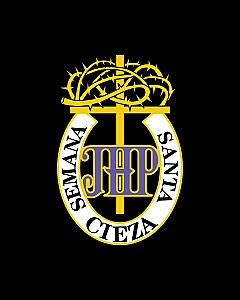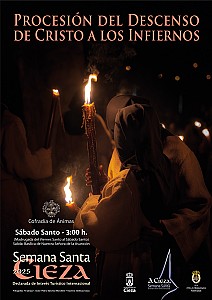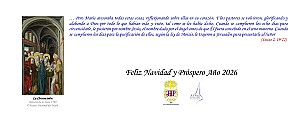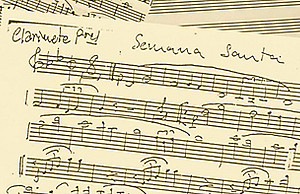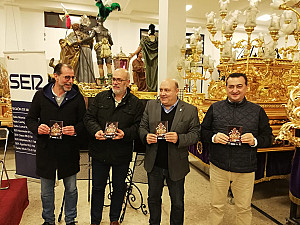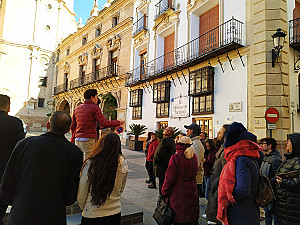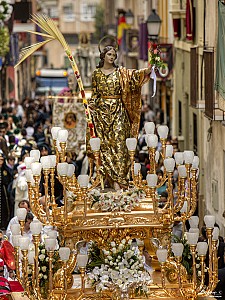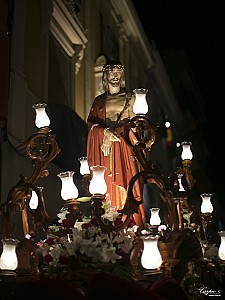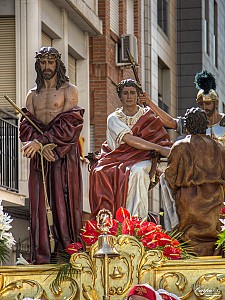El origen de la Cofradía de San Juan Evangelista está ligada a la historia por su primitiva Imagen, propiedad de Dña. Francisca de la Peña Aledo. Nacida el 28 de noviembre de 1818, era la hija de D. Juan de la Peña Angosto y Dña. Juana Aledo Quílez.
Guiada por su seráfica existencia, Francisca de la Peña convertiría en un auténtico santuario el piso alto de la casa familiar. Este oratorio particular incluía una Purísima Concepción, otra escultura de San Francisco y la talla de San Juan, todas ellas, cobijadas en tres nichos adornados con vidrieras.
Parece ser que San Juan obedeció a un recuerdo trágico. El 23 de noviembre de 1809 nació su hermano Juan de la Peña, para ser, a una muy temprana edad, víctima de la tuberculosis en 1831. Con veintidos años era el primogénito, el único varón, y bruñía la tradición de llamarse Juan. La pequeña Francisca sintió con trece años su irreparable pérdida.
La alegría y la juventud del adorado hermano se transfiguraron en la imagen del 'Discípulo Amado', cuya devoción y culto se asemejó al imperecedero recuerdo familiar. Su fervor por San Juan le animó a fundar una cofradía en 1856, asumiendo su mantenimiento económico.
A ella le correspondió ser la primera camarera, tal y como se recoge en el libro, que consta por oden alfabético, el nombre de los hermanos de la Cofradía de San Juan Evangelista desde su fundación en 1856 hasta 1885. En total, 108 fueron los fundadores, de los cuales, despunta un amplio grupo de personas unicas por los anchurosos lazos de sangre con los Peña.
Y tal y como se constató con anterioridad, serán los Peña los encargados del sustento económico de San Juan hasta que a finales del siglo XIX fueran sustituidos por la familia López, y a mediados del siglo XX por los Pérez y los Templado.
La Cofradía destaca por tres peculiaridades: la primera, la incorporación a sus filas de un grupo profesional suturado por la común pertenencia al campo de la medicina; la segunda, una multitud de jóvenes que siempre acompañará en alegre chiquillería al más jóven de los discípulos; y la tercera, la armoniosa tonalidad de las notas de la orquesta de su Cofradía.
En este aspecto, el espíritu de la Cofradía ha corrido paralelamente al de su orquesta, que bien pudo organizarse en 1892 bajo la dirección del inolvidable Maestro D. Antonio León Piñera, como parece deducirse de unas notas de prensa aparecidas en el semanario de la época 'El Enredo' con fechas de 17 y 24 de abril de 1892; en la primera de ellas el articulista, M. Dulce, amén de destacar la contribución a la brillantez de los desfiles de la mencionada Orquesta, se permite aconsejar a la Cofradía que para el futuro, y a imitación de otras, compre túnicas, pague tarjas y aumente así el número de Cofrades. En la segunda, el que la escribe elogia a la "nueva Orquesta que bajo la dirección del Maestro León Piñera amenizó las Procesiones de Jueves Santo y Viernes Santo en la Cofradía de S. Juan Evangelista", refiriéndose también al "galante comportamiento que con dicha orquesta han tenido los Cofrades Mayores de dicha Cofradía, los Señores D. José Peña y Marín y D. Juan Pérez López, quienes obsequiaron a dicha Orquesta con un refresco en la casa de D. Ignacio Amoraga". Precisamente uno de sus primeros violinistas solistas fue D. José Marín Blázquez y Marín Barnuevo, hermano de Dña. Adela, y entre otros fueron sus primeros componentes Miguel Ruis Peña, Gerónimo Salmerón Gómez, José Marín Fernándes y José Gálvez.
Es evidente que la orquesta se creó para interpretar las dos marchas que el Maestro León compusiera y que su pasodoble 'San Juan, San Juan...' pronto se hizo famoso como evidencian las numerosas anécdotas recogidas sobre el mismo. Tempranamente comenzó la chiquillería y el pueblo en general a tararear los conocidísimos versos "San Juan, San Juan se va a caer \ San Rafael lo va a coger". Este estribillo no se debe sino a que la Imagen de San Juan se veneraba en la Ermita del Santísimo Cristo del Consuelo frente a la Imagen de San Rafael que por la posición de sus brazos parecía esperar que San Juan cayera en ellos. Más tarde Don Juan Pérez Templado recogería estos versos para escribir la letra completa del pasodoble.
En torno a 1915 la orquesta vive su época dorada dirigida por Don José Gálvez quien hacía sonar hasta cuarenta violines como uno solo. Tras unos años de titubeos y siendo Alcalde Don Antonio Pérez se encargó de formar una orquesta completa D. Manuel Pérez Pérez, notable violinista discípulo de D. José Gálvez. Precisamente a la muerte de éste fueron constantes las desapariciones y reapariciones de la misma. Su último esplendor lo vivió a partir de 1975 bajo la batuta del Maestro Germán Galindo, con el que tocaba, entre otros, D. Francisco Lucas Navarro, ex-Alcalde de Cieza. Tras la muerte de ambos, dada la avanzada edad de algunos de sus componentes y pese a que se renovó notablemente, la orquesta de San Juan dejó de desfilar en l989. Hasta que en 2023, gracias a la labor de dos 'sanjuanistas', en la noche del Viernes Santo volvieron los sones de la castiza orquesta.
Por lo que al Paso de San Juan se refiere, provisionalmente y entre la Semana Santa de 1890 y 1891 se hace cargo de la Imagen Dña. Ana Pérez Martínez, madre de D. Federico de Arce y muy ligada a los señores del Mayorazgo de Ascoy. Toma el relevo D. Juan Pérez López, que permanecerá en la Presidencia de la Cofradía hasta su muerte en 1919. De 1893 es un artículo firmado por E.B. en el que se decía, en la descripción de la Procesión General, entonces Jueves Santo, "en sexto lugar marchaba San Juan precedido de numerosa concurrencia de nazarenos blancos. Este Paso lucía diferentes ramos de matizadas flores de artificio, realizadas en París por encargo de las hijas de D. Juan Pérez López, a cuyo exquisito gusto está confiado el arreglo del Paso".
A D. Juan Pérez le sucede su hijo D. Julián Pérez Cano, siendo entonces la Camarera su esposa Dña. Visitación Templado Martínez. D. Julián Pérez y su hermano D. Antonio encargaron el retablo neogótico de San Juan para la Ermita del Santísimo Cristo del Consuelo, donde siempre se guardó la Imagen. Era tradicional verlo bajar en la popular 'Traída de los Santos' junto con las otras Imágenes que tenían allí su sitio para participar en los Desfiles Procesionales. San Juan se arreglaba en un cocherón que había en la parte trasera de dicha ermita junto a la casa del capellán; las túnicas se repartían en la casa de D. Julián, en el camino de Murcia, y desde allí se partía para el Traslado; llegados al Camino de Madrid, junto al 'Pilar de los burros' la Cofradía se adelantaba para cogerlo en andas mientras la orquesta aguardaba allí la llegada del Paso.
Cuando la 'Traída de los Santos' desde la ermita del Santísimo Cristo del Consuelo dejó de realizarse en el año 1957, la Imagen con su retablo se instaló en la Basílica de Nuestra Señora de la Asunción. No obstante la Cofradía mantiene todavía su popular Traslado del Miércoles Santo que se verifica desde distintos puntos de la localidad y al que se suma con Paso propio el Tercio infantil de la misma.
Como ocurrió con tantas otras, el barbarismo de la Guerra Civil destruyó la antigua Imagen de San Juan esculpida por Manuel López Guillén en 1907. Fue quemada en la ermita el 28 de agosto de 1936, salvándose tan sólo la cabeza que fue recogida y entregada a D. Julián Pérez Cano que la guardó en su casa durante toda la contienda. La Imagen fue reconstruida en 1940 por el escultor José Planes, que talló el cuerpo, y por el imaginero ciezano Manuel Juan Carrillo Marco, que hizo lo propio con las manos y los pies. El Paso no obstante ofrecía algunas diferencias con el primitivo: este representaba a un San Juan en el que el cuerpo no guardaba las proporciones con la cabeza; asimismo portaba una palma en la mano derecha mientras señalaba hacia el frente con la izquierda. El actual, una talla más pequeña, se recoge la túnica con la mano derecha a la vez que simula sujetar la palma, que siempre lleva una guirnalda de flores menudas siguiendo la tradición que iniciara Dña. Visitación Templado. El propio Maestro Carrillo asumió en 1987 la limpieza y restauración de la Imagen, que volvió a ser restaurada en 2009 por la empresa valenciana de restauración Gaia, bajo la tutela de la Dirección General de Bellas Artes de la Comunidad Autónoma de la Región de Murcia.
Del trono conocemos que fue dorado, según indicaba una esquela que llevaba adherida en su interior, en 1894 por Miguel Amoraga, y se sabe que pasó por el taller del maestro ebanista José Izquierdo (1880), artista catalán que por los últimos años del siglo pasado se había establecido en Cieza. Fue remozado definitivamente entre 1956 y 1957 por Manuel Juan Carrillo Marco, que lo completó con varias tallas, renovó el arbolado de luces y le añadió unos jarrones y cuatro águilas plateadas. Con posterioridad en los Talleres de los Hermanos Lorente se restauró la peana superior y se hizo una nueva en la parte inferior para poder aumentar el número de varas de tres a cuatro. Finalmente en 2010 fue nuevamente restaurado y vuelto a dorar en el taller del tronista ciezano Bonifacio Pérez Ballesteros, bajo la presidencia de D. Antonio Lucas García, que sucedió a su padre, D. Antonio Lucas Lajara en 2004.
Tras la finalización de la Guerra Civil y con la reinstauración de las procesiones San Juan volvió a desfilar por las calles de Cieza, arreglándose durante algunos años en la capilla de San Pascual en el Convento de San Joaquín y San Pascual. D. Julián y D. Antonio Pérez Cano tramitan la legalización de la Cofradía, que se refunda en 1948, después de haber introducido en la Cofradía en la Semana Santa de 1944 los báculos de luz eléctrica, báculos que fueron sustituidos en 1997 por otros de nuevo diseño realizados por el orfebre ciezano Francisco Penalva, y las túnicas de lujo.
En 1962 fallece D. Julián Pérez Cano, primer Comisario de Honor de la Junta de Hermandades Pasionarias y Presidente Honorífico de la Cofradía de San Juan, y le sustituye D. Juan María Buitrago Iniesta, quien encarga para la Semana Santa de 1971 un estandarte bordado en oro por ambos lados con gran lujo de pedrería a la cartagenera Dña. Consuelo Escámez. A él se debe también la adquisición de un nuevo Paso para la Procesión del Prendimiento: Ecce Homo, esculpido por Juan González Moreno en 1972, que se expone para su culto desde 1989 en la Basílica de Nuestra Señora de la Asunción y que había venido desfilando sobre un trono, adquirido en Murcia, realizado en madera y dorado en los Talleres de los Hermanos Lorente en 1970, hasta el año 2004, año en que la Cofradía estrena un nuevo trono, de aires sevillanos, realizado y acabado en madera, obra del artista de Albatera, Domingo García Chauán, al que se le añaden en 2006 cartelas plateadas realizadas en el taller ciezano de Francisco Penalva. La Imagen fue restaurada en 2009 por la empresa valenciana de restauración Gaia, bajo la tutela de la Dirección General de Bellas Artes de la Comunidad Autónoma de la Región de Murcia. Ese mismo año fue el último que el Paso desfiló en la Procesión del Prendimiento, pues en virtud del acuerdo de restructuración de las Procesiones adoptado en 2004 por la Junta de Hermandades Pasionarias es ubicado en la Procesión General, en la que desfila ya en 2011, lo que motiva que el Titular de la Cofradía deje de participar en la misma.
Tras la muerte de D. Juan María Buitrago dirigen la Cofradía sucesivamente D. Agustín Gómez Pastor y D. Antonio Lucas Lajara. Bajo la presidencia de éste último se encargan en 1984 al orfebre ciezano Francisco Penalva dos faroles para el Tercio de Nazarenos, Bienvenida Semitiel borda un nuevo juego de galas para los tronos de la Cofradía y en el año 1993 la Cofradía estrena el Paso 'El Lavatorio de Pilato' -que desfila desde 2011 bajo la advocación de 'La Sentencia'- con Imágenes realizadas en madera y enlienzadas por el escultor jumillano Mariano Spiteri (el mismo reformará su policromía en el año 2001) y trono tallado en madera y dorado por Manuel Lorente Sánchez ese mismo año. Durante algunos años la Cofradía opta por participar en el Desfile Procesional de la mañana de Viernes Santo con el nuevo Paso además del Paso Titular, hasta que en 2006 decide que éste último deje de hacerlo en esa Procesión. De ese modo el Paso San Juan que había venido participando en las Procesiones General, del Penitente, del Santo Entierro y de Jesús Resucitado, ve finalmente reducidas sus salidas a estas dos últimas Procesiones.
Finalmente en 1997 la Cofradía recupera para su Tercio de anderos el tradicional gorro de 'moco' y en 2011, para acompañar a los Pasos del Ecce Homo y San Juan, instaura para sus Tercios de anderos y nazarenos el gorro de 'verdugo'.
Fotografías de Manuel Carpio.
© Junta de Hermandades Pasionarias de Cieza
